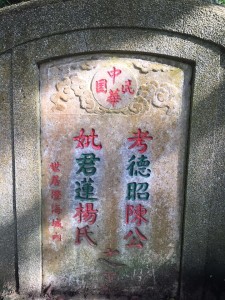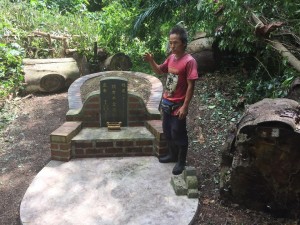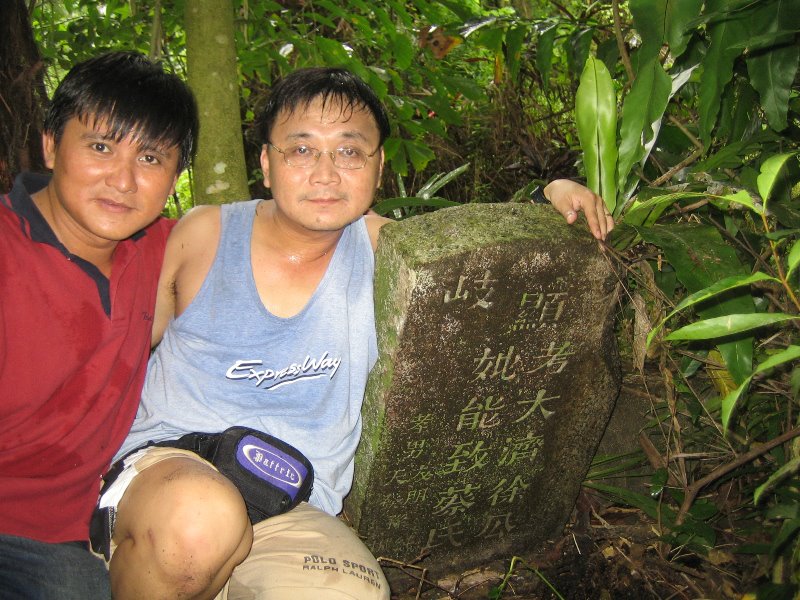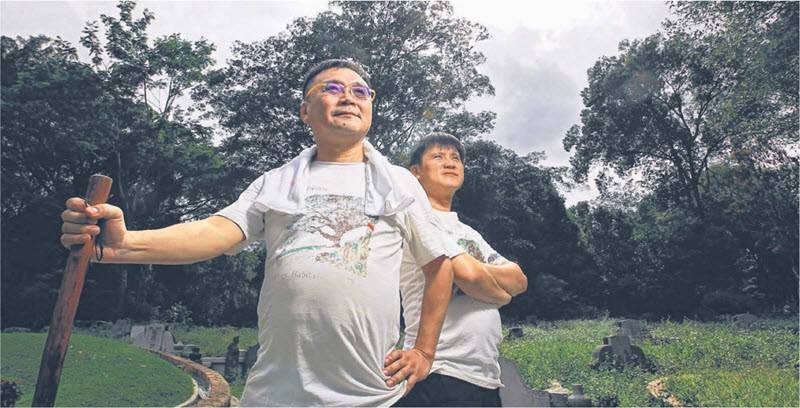Goh Brothers – A Decade of Exploring, A Decade of Sharing
3It’s the end of another weekend and rarely a weekend passes when Raymond Goh aka “Tomb Whisperer” is not to be found doing ground exploration and research at Bukit Brown, nowadays often with tombkeeper Soh who helps him bush bash and lends his knowledge of the grounds he grew up in.
Today’s sharing on his “finds” on the Heritage Singapore Bukit Brown FB group included a tomb “gift wrapped” in Peranakan tiles, a newly refurbished tomb ( more signs that descendants are returning) , a tomb with a story to be unraveled, and a tomb bearing 中華民國 – Republic Of China.
Unusually Raymond was also at Bukit Brown this Saturday (he splits weekend days between his family and his passion ) to meet an independent researcher who hopes to write an article on a prominent pioneer whose tomb Raymond had found much earlier and wanted to tap his knowledge
Then I learned that much earlier in the week, Raymond got up at 4 am one weekday morning so he could help facilitate a fervent request by an international documentary crew to film an exhumation at Bukit Brown. Exhumations are private family affairs and it was indeed a testimony to Raymond’s reputation for sensitivity and discretion in such matters that he was able to persuade family to allow for the filming and be interviewed.
All in a weeks work you could say for Raymond who has to juggle his passion with his career heading a multi- national healthcare company which finds him traveling on average once a month on business trips.
It is a passion which can be traced back a decade when he teamed up at the instigation of his younger brother Charles – who heads workplace safety and health at a Japanese firm – to explore and uncover the “lost heritage and history of Singapore”. The siblings have more than a blood bond, as they leverage on each other’s strengths. It was Raymond’s interest in Chinese and regional culture and history which Charles’ sought to complement his own skills in map-reading and understanding of title deeds and ownership.
Their decade of exploration and what they have uncovered including the community which has rallied around them was documented recently in a feature called Life Extraordinare
http://video.toggle.sg/en/series/life-extraordinaire/ep8/358863
The Goh brothers intrepid exploration of forgotten places – more often than not sited in thick forested areas – paired with their investigative work trawling the archives for maps and records, have helped Singaporeans connect to their past, and sparked personal journeys into the search for their roots for a new generation of Singaporeans.
The discovery of the grave of Singapore’s foremost Teochew pioneer Seah Eu Chin (1805-1883) by the Goh brothers in November 2012 is an exemplar of their commitment and passion, one with wider resonance in 2015.
In 2011, prompted by a request from a descendant of Seah who went to school with Raymond, they found a Straits Times obituary (1883) that described Seah Eu Chin’s funeral procession, from his home in North Boat Quay to his plantation in Thomson Road, about 4.8km away from town. From the description of the funeral procession, Charles extrapolated the approximate location from a 1924 map. But to confirm whether it was indeed the grave of Seah Eu Chin, what was needed was an understanding of the Chinese practice whereby family members of the same generation used the same characters in their names. And that was where Raymond’s interest in Chinese culture and tradition came to the fore.
“Knowing the generation name, which was certified in an imperial edict he found, helped him confirm that the grave he found on Grave Hill belonged to Seah Eu Chin”. ST Nov 28, 2012, Teochew pioneer’s grave found in Toa Payoh
Of the discovery, Dr Hui Yew-Foong, an anthropologist at the Institute of Southeast Asian Studies and the appointed documentarian of Bukit Brown Cemetery commented, “This grave is of the same level of historical significance as the graves of Tan Tock Seng and Tan Kim Ching, and therefore serves as an invaluable part of Singapore’s heritage.”
For the Goh brothers it was mission accomplished. For the Seah clan, it was the beginning of the unravelling of familial connections lost after the devastation of World War II. Before the war, the 2,000-strong family of descendants spanning at least five generations had gathered regularly. The 130th anniversary of Seah Eu Chin’s death was marked at his grave site in 2013 a year later by descendants and members of the two Teochew Clan Associations he help found, the Po Ip Huay Kuan and Ngee Ann Kongsi.
For Sean Seah 39, a 6th generation descendant of Seah Eu Chin who took part in the memorial prayers, it was followed by a journey tracing the steps of personal history when he made a trip back to the ancestral home and villa of Seah Eu Chin in Yuepu village, Chaozhou province in 2014 which he documented in this video. https://vimeo.com/95650452
“When I was young, my father used to tell me stories about Seah Eu Chin. when I went to school, I learnt more about him, but many questions still lingered. When I gazed upon and touched the tomb of Seah Eu Chin, I felt a a tangible visceral connection to my roots and moved to embark on a quest for these questions to be answered, and so to the Goh brothers, I am grateful” – Sean Seah (personal communication)
Intrigued by this unearthing of history, in November 2015, the Goh brothers revealed the significance of two stone markers they found in MacRitchie area. One was inscribed with the words “Dare” in English and the other “Seah Chin Hin” in Chinese for Mr Seah’s plantation, as well as the stone and brick foundations of Mr Dare’s former home. “Dare” was George Mildmay Dare a former secretary of the Singapore Cricket Club. The two stone markers are discoveries which tell the complementary stories of the land, of our colonial past and our migrant pioneers.
The Goh brothers cache lie in ignominious stones, the kind you trip upon when taking a road less travelled but when examined closer becomes a doorway to our historical landmarks.
The curiosity as well as the passion for our history drives them to search on the ground as well as delve into archives for supporting evidence or clues. Charles was exploring the old forested area near Macalister Road when he stumbled upon a wall in the grounds of the Singapore General Hospital in September 2014. The National Heritage Board was alerted to its discovery by the Goh brothers and through further research, found that the remnants belonged to the New Lunatic Asylum which 128 years ago was revolutionary for its time, a period when strait jackets was more the norm. The perimeter wall was to allow patients to move about freely under protection. Within the grounds of the SGH carpark, which was undergoing development in 2014, was also the remnants of a burial site belonging to a Chua clan dating back to the 1860s, occupying a private strip of land then sandwiched between Tiong Bahru (New Cemetery) and Tiong Lama (Old Cemetery) that would have been referred to as Seh Chua Sua (Chua Hill) On a visit to the site led by Raymond and Charles organised by the Tiong Bahru heritage group earlier this year , participants found four gravestones cordoned off for protection in the midst of the construction site.
2015 is a significant year for the Goh brothers as it marks a decade of exploration of Bukit Brown Cemetery and the adjoining cemeteries which have become an important memory marker for Singaporeans.
It is what the Goh brothers have become most known for in the public consciousness, ironically because of the unexpected controversy which erupted in 2011 when the government revealed plans to build an 8 -lane highway across the last remaining Chinese cemetery, one with a history dating back to the 1800s. The Goh brothers had started to explore Bukit Brown as early as 2005, and uncovered the tombs of pioneers such as Cheang Hong Lim, Tan Keong Saik, Khoo Siok Wan, Seah Imm, Tan Ean Kiam, Chew Boon Lay, Chew Joo Chiat, Tan Kheam Hock – more than 30 pioneers to date whose names are immortalised in our streetscape.
By 2011, they had the best working knowledge on the ground of Bukit Brown which had closed in 1973 – the final resting place of an estimated 100,000 pioneers and whose terrain had become overgrown, the kind of challenging landscape the Goh brothers relished.
As descendants’ awareness of their familial obligations to claim and exhume their forebears grew, it was to the Goh brothers that they turned to unravel the clues to locate ancestors’ graves or other related information lost to time. Others, their interest piqued by the circumstances, started to trace if they had ancestors buried there, leading to even more leads to chase.
Many who requested help from the Goh brothers to trace their ancestors even mistook Raymond as being employed by Land Transport Authority to help them verify whether the graves of their ancestors would be affected by the highway. Both brothers were members of the Advisory Council on the Bukit Brown Documentation Project, a committee set up by the government in recognition of the heritage and historical value the cemetery. It was made up of stakeholders who could advise on documentation of the approximately 4000 graves which had to be exhumed to make way for the highway. Nonetheless, their endeavours were beyond the remit of the advisory council, and testament to the true value of the Goh brothers to the broader community.
It was this broader interest in helping descendants seek their ancestors, regardless if they were affected by the highway, that resonated with ordinary Singaporeans and residents.
Besides Seah Eu Chin, early clues in Bukit Brown also led to the discovery of Chia Ann Siang, who was not buried there. The discovery of Chia Ann Siang’s grave in a forested hilllock off Malcolm Road, also led to reunions and connections. Alphonsus Sng, 6th generation Chia Ann Siang writes,
” We were told growing up we were descendants of Chia Ann Siang on my mother’s side, but it was not until his grave was discovered by the Goh brothers, that we could confirm, from the names of his sons etched on his grave we were in fact descendants from his 3rd son Beng Chiang, who was my great grandfather on my maternal side. The reunion at the grave was a first in meeting cousins we never knew existed of my generation, descended directly from Chia Ann Siang. We have since kept in touch, exploring our shared ancestry together” – Alphonsus Sng (personal communication)
Raymond Goh estimates that he has helped to connect about 50 families whose roots are in Bukit Brown. But the Goh brothers’ contribution in a body of work that spans a decade is exponential.
Leveraging on their research, a community of volunteers came together in 2012 almost spontaneously and started conducting regular public walks in Bukit Brown to instill awareness on its intrinsic heritage and history, some later expanding on the research of the Goh brothers to conduct their own independent research. They became collectively known as the “Brownies” – a motley group from different professional backgrounds from lawyers to engineers, of different faiths, different ethnicity including a Sikh and a Catholic Indian. The youngest is below 30 of age the oldest, above 60. For them Bukit Brown has taken them to places outside of Bukit Brown and indeed out of Singapore to explore the history and heritage of our migrant roots, our diaspora. A handful have also joined the ranks of Raymond and Charles in helping to connect descendants with ancestors.
“2015, Singapore’s Jubilee, was a year to take stock of where we are heading, and where we came from. In this connection, very few ordinary Singaporeans can claim to have played as significant a role in helping us appreciate our past. Raymond and Charles Goh are arguably pioneers in their own right in exploring and sharing with the public the significance of cemeteries, particularly, Bukit Brown in linking the dots between the past and the present, the departed and those living
On a personal note, I have had the pleasure to be a former classmate of Raymond and we are both alumni of Gan Eng Seng. I was moved by the tour of Bukit Brown conducted by Raymond which culminated in homage paid at the tomb of our school’s founder. This reminded me of the Raymond Goh I remembered when he was a boy, a classmate with an enquiring mind, a strong sense of curiosity, who excelled in the sciences. I am proud that he has applied these skills in his Bukit Brown related pursuits, for he is an excellent detective and investigator of the past.” Khir Johari, Singapore Heritage Society, SHS Vice President (personal communication)
The Goh brother’s decade-long track record, and an undaunted and persevering spirit to a cause despite a lack of early support have been self-less. They have willingly shared their knowledge and skills and created space for other like-minded persons to follow in their very large footsteps. They have inspired other volunteers, but also a broader public, which has opened their eyes to alternative histories and an independent route of inquiry.
In the words of a recent reflection by journalist Lisabel Ting in the last week of 2015.
“Like a salmon swimming upstream, I think all humans have an innate desire to return to where we came from and to site ourselves in the continuum of history by knowing what has come before. …..This urge to return to our source may be particularly compelling for Singaporeans, especially the many of us who are culturally adrift and loosely moored to this island only by the strength of several generations.For the majority of us, whose parents and grandparents hail from countries across the ocean, our kin are scattered around the world, and may be culturally and linguistically distinct.Having a family tree on which to hang our heritage could, in an impalpable sense, provide a sense of deep-rooted belonging or affiliation which is sometimes missing here.” ST 29 December 2015 “ My surreal connection to my ancestral home”
Today 24 January, 2016, I came across another reflection which resonated ” We cannot protect what we do not know” and the Goh brothers have shared what they know and will continue to explore and unravel so we can also also embark on our personal journeys to learn.








Hi Raymond ,
How to contact you?
You can send email to him at starhub@gmail.com
Hi Raymond, thank you so much for the hard work and it has helped us significantly in locating our forefathers. Is there a way to reach you? Is this email mailto:starhub@gmail.com valid?
Thank you